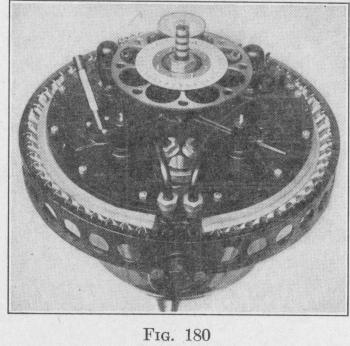228 NAVIGATIONAL COMPASSES
in Fig. 180. A group of springs connecting the compass to one of the gimbal rings, and a rod of felt between the springs and the compass, serve to reduce vibration. The thermometer at the left, and the two tubes that extend from the top plate of the compass to the trunnion in the foreground, are parts of the system that controls the temperature of the liquid in the outer containing vessel.
137. Damping. - Two different methods are used on different models of the Anschutz gyro-compass for producing damping of the vibrations of the sensitive element. In the first method to be described, an annular tube is fastened, with the plane of the ring horizontal, to the frame that carries the gyros. The tube is partly filled with oil. If the sensitive element tilts, oil flows from one part of the tube to the part diametrically opposite. The flow is retarded by a set of partitions across the bore of the tube, each partition being pierced by an aperture of predetermined size. The operation of this damping system is as follows. When the meridian-seeking axis of the sensitive element moves east of the meridian, the north point of the compass card will rise till the gravitational torque due to the tilted pendulous system precesses the axis back to the meridian (Art. 106). The north point of the compass card continues to move after traversing the meridian, decreasing its upward tilt as it moves west of the meridian. After reaching a maximum displacement west it moves eastward and dips below the horizontal. After traversing the meridian in the eastward direction, the dip decreases and becomes zero when the maximum deflection eastward is produced.
THE ANSCHUTZ GYRO-COMPASS 229
While the sensitive element is tilting up and down the oil in the damping device moves back and forth. While the north-seeking end of the sensitive element is above the horizontal, that is while the north point of the compass card is moving westward, there is an excess of oil in the south side of the damping device. Similarly, there is an excess of oil in the north side of the damping device while the north point of the compass card is moving eastward. The torque produced by the ununiform distribution of oil in the damping device is, at all times, in the direction opposite the gravitational torque due to the tilted pendulous sensitive element. Thus the tendency to precess, due to the tilting of the oscillating sensitive element is diminished at every instant by a torque due to the displaced oil in the damping device. This torque does not oppose precession but reduces the effective pendulousness of the sensitive element.
In the second method, the oscillations of the sensitive element are damped by a pair of tiny Frahm anti-roll tanks, T,, T2, Fig. 177, fastened to the inner surface of the gyro-globe. Consider a gyro-wheel and casing to which are attached two connected oil tanks forming a pendulous system capable of oscillation about an axle through x, Fig. 181. The reservoirs are half filled with oil. If the connecting tubes were stopped up or if they were sufficiently large in diameter, the device would produce no damping of the vibrations of the pendulous system. If, however, there be a considerable opposition to the flow of oil, then when one reservoir is higher than the other, oil will flow slowly from the higher to the lower reservoir. By the time that the pendulous system is vertical there will be an excess of oil in the reservoir that was the lower, Fig. 182. Later, there will be a flow in the opposite direction, followed by a flow back and forth at a definite period. The period, as well as the phase difference between the oscillation of the oil and of the pendulous system, can be regulated by an adjustment of a valve in either of the tubes that connect the two reservoirs.
If the period of flow back and forth equals the period of vibration of the pendulous system, and if there is a phase difference of a quarter period between the motion of the oil and the motion of the pendulous system, the following effects will occur. When the axle of the spinning gyro-wheel is in the meridian plane, the northseeking end of the axle will be higher than the south-seeking end and will be moving westward (Art. 106). At some such instant,
